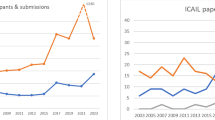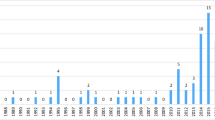Abstract
Inspired by Professor Jianhong Liu’s article entitled “Asian Criminology—Challenges, Opportunities, and Directions,” published in 2009 in the Asian Journal of Criminology, I attempt to document the expansion of Asian criminology in terms of the numbers of journal articles published, but also to encapsulate some of the unique contributions of original articles published in the Asian Journal of Criminology. To document the expansion of Asian criminology in terms of journal articles, I used the academic search engine, the ISI Web of Science, to identify criminology articles across a variety of Asian countries and time. This led to distinguishing between more traditional criminology and crime control (TCCC) articles and articles focusing on violence against women/children and on trafficking (VAWCT). Second, because it is not yet part of the ISI Web of Science, I read all of the original articles in the Asian Journal of Criminology to account for how Asian criminology is advancing the larger discipline of criminology. The ISI Web of Science data document the rapid expansion of Asian criminology. Some of the specific Asian Journal of Criminology articles are used to exemplify specific examples of how Asian criminology is advancing the field of criminology worldwide through theoretical, methodological and framing designs, and crime control practices.

Similar content being viewed by others
Notes
I conducted the ISI Web of Science search for traditional criminology publications on June 10, 2015 and the ISI Web of Science search for violence against women and children/trafficking search on June 15, 2015.
While presenting this conference at the 7th Annual Conference of the Asian Society of Criminology, one member of the audience correctly identified “cyber-crimes” as an area that should be included.
Quraishi’s work from these data are also in his 2005 book Muslims and Crime: A Comparative Study.
References
Belknap, J. (2015a). The invisible woman: gender, crime, and justice (4th ed.). Belmont: Wadsworth.
Belknap, J. (2015b). Activist criminology: criminologists’ responsibility to advocate for social and legal justice. Criminology, 53(1), 1–22.
Belknap, J., Larson, D.-L., Abrams, M. L., Garcia, C., & Anderson-Block, K. (2012). Types of intimate partner homicides committed by women: self-defense, proxy/retaliation, and sexual proprietariness. Homicide Studies, 16(4), 359–379.
Benini, A., Owen, T., & Rue, H. (2008). A semi-parametric spatial regression approach to post-war human security: Cambodia, 2002–2004. Asian Journal of Criminology, 3(2), 139–158.
Boriboonthana, Y., & Sangbuangamlum, S. (2013). Effectiveness of the restorative justice process on crime victims and adult offenders in Thailand. Asian Journal of Criminology, 8(4), 277–286.
Bui, L. (2014). Examining the relationship between parenting, risk-taking, and delinquency in Japan: Context and empirical applicability. Asian Journal of Criminology, 9(3), 171--187.
Chan, C. Y. A. (2007). Hostility in homicide–suicide events: a typological analysis with data from a Chinese society, Hong Kong, 1989–2003. Asian Journal of Criminology, 2(1), 1–18.
Chan, W.-C. (2013). Family conferencing for juvenile offenders: A Singaporean case study in restorative justice. Asian Journal of Criminology, 8(1), 1--23.
Chen, G. (2009). Patterns of crime and substance abuse among Israeli ex-addict female inmates. Asian Journal of Criminology, 4(1), 47–60.
Chin, K.-L. (2007). Into the thick of it: methodological issues in studying the drug trade in the Golden Triangle. Asian Journal of Criminology, 2(2), 85–109.
Chui, W. H., & Cheng, K. K.-y. (2013). Effects of volunteering experiences and motivations on attitudes toward prisoners: evidence from Hong Kong. Asian Journal of Criminology, 8(2), 103–114.
Dai, M., & Gao, H. (2014). Drug users’ satisfaction with drug control by the police in China. Asian Journal of Criminology, 9(3), 205–219.
DeHart, D., Lynch, S., Belknap, J., Dass-Brailsford, P., & Green, B. (2014). Life history models of female offending: the roles of serious mental illness and trauma in women’s pathways to jail. Psychology of Women Quarterly, 38(1), 138–151.
DePrince, A. P., Belknap, J., Labus, J. S., Buckingham, S. E., & Gover, A. R. (2012). The impact of victim-focused outreach on criminal legal system outcomes following police-reported intimate partner abuse. Violence Against Women, 18(8), 861–881.
Drissel, D. (2006). Subterranean sources of juvenile delinquency in China: Evidence from birth cohort surveys. Asian Journal of Criminology, 1(2), 137--154.
Erez, E., & Belknap, J. (1998). In their own words: battered women’s assessment of the criminal processing system’s responses. Violence and Victims, 13(3), 251–268.
Ferraro, K. J. (1989). Policing woman battering. Social Problems, 36(1), 61–74.
Gaarder, E., & Belknap, J. (2004). Tenuous borders: girls transferred to adult court. In B. R. Price & N. J. Sokoloff (Eds.), The criminal justice system and women: offenders, prisoners, victims, and workers (3rd ed., pp. 69–93). Boston: McGraw-Hill.
Gideon, L., & Hsiao, Y. G. (2012). Stereotypical knowledge and age in relation to prediction of public support for rehabilitation: data from Taiwan. Asian Journal of Criminology, 7(4), 309–326.
Gingerich, T., & Chu, D. (2006). A comparative perspective of community policing in Taiwan and Washington state. Asian Journal of Criminology, 1(2), 119–135.
Herber, E. (2014). Dealing with the aftermath of Japan’s triple disaster: building social capital through crime prevention. Asian Journal of Criminology, 9(2), 143–159.
Huang, H.-L. (2009). Where are our daughters, mothers, sisters, and wives?: a typological analysis of missing women and girls in greater China, 1900–2000s. Asian Journal of Criminology, 7(4), 295–308.
Huang, H.-f., & Chang, L. Y. C. (2013). Evaluating restorative justice programs in Taiwan. Asian Journal of Criminology, 8(4), 287–307.
Huang, L., & Lin, Y. (2014). Determinants of police-filed petitions for protection orders in Taiwan: comparing predictive factor salience in intimate partner violence cases in the USA and Taiwan. Asian Journal of Criminology, 9(4), 301–322.
Huang, H.-f., Braithwaite, V., Tsutomi, H., Hosio, Y., & Braithwaite, J. (2012). Social capital, rehabilitation, tradition: support for restorative justice in Japan and Australia. Asian Journal of Criminology, 7(4), 295–308.
Hwang, S., & Akers, R. L. (2006). Parental and peer influences on adolescent drug use in Korea. Asian Journal of Criminology, 1(1), 51–69.
Jeffries, S. (2014). The imprisonment of women in Southeast Asia: trends, patterns, comparisons and the need for further research. Asian Journal of Criminology, 9(4), 51–69.
Jiang, S., & Lambert, E. G. (2012). Introduction: Social control in Asian countries. Asian Journal of Criminology, 7(2), 101--105.
Jiang, S., Land, K. C., & Wang, J. (2013). Social ties, collective efficacy and perceived neighborhood property crime in Guangzhou, China. Asian Journal of Criminology, 8(3), 253–269.
Jiao, A. Y. (2010). Controlling corruption and misconduct: a comparative examination of police practices in Hong Kong and New York. Asian Journal of Criminology, 5(1), 27–44.
Jo, Y., & Zhang, Y. (2012). The stability of self-control: a group-based approach. Asian Journal of Criminology, 7(2), 173–191.
Johnson, D. T. (2013). The jolly hangman, the jailed journalist, and the decline of Singapore’s death penalty. Asian Journal of Criminology, 8(1), 41--59.
Joo, H. J. (2015). Crime and criminal justice in South Korea. Asian Journal of Criminology, 10(1), 1–6.
Joo, H. J., & Jo, Y. (2015). Family, school, peers, and recidivism among south Korean juvenile offenders: an event history analysis. Asian Journal of Criminology, 10(1), 99–116.
Latha, S., & Thilagaraj, R. (2013). Restorative justice in India. Asian Journal of Criminology, 8(4), 309–313.
Lin, W.-H. (2012). General strain theory in Taiwan: a latent growth curve modeling approach. Asian Journal of Criminology, 7(1), 37–54.
Liu, J. (2007). Principles of restorative justice and Confucius philosophy in China. European Forum for Restorative Justice 8(1):2--3.
Liu, J. (2009). Asian criminology–challenges, opportunities, and directions. Asian Journal of Criminology, 4(1), 1–9.
Lo, T. W., & Jiang, G. (2006). Inequality, crime and the floating population in China. Asian Journal of Criminology, 1(2), 103–118.
McDaniels-Wilson, C., & Belknap, J. (2008). The extensive sexual violation and sexual abuse histories of incarcerated women. Violence Against Women, 14(10), 1090–1127.
Mok, L. W. Y., & Wong, D. S. W. (2013). Restorative justice and mediation: diverged or converged? Asian Journal of Criminology, 8(4), 335–347.
Ngoc, A. C., & Wyatt, T. (2013). A green criminological exploration of illegal wildlife trade in Vietnam. Asian Journal of Criminology, 8(2), 129–142.
Park, S. M. (2015). A study of over-dispersed household victimizations in South Korea: zero-inflated negative binomial analysis of Korean national crime victimization survey. Asian Journal of Criminology, 10(1), 63–78.
Potter, H. (2013). Intersectional criminology: interrogating identity and power in criminological research and theory. Critical Criminology, 21(3), 305–318. doi:10.1007/s10612-013-9203-6.
Potter, H. (2015). Intersectionality and criminology: disrupting and revolutionizing studies of crime. New York: Routledge.
Quraishi, M. (2005). Muslims and crime: a comparative study. Burlington, VT: Ashgate.
Quraishi, M. (2008). The racial construction of urban spaces in Britain and Pakistan. Asian Journal of Criminology, 3(2), 159–171.
Stevenson, B. (2014). Just mercy: a story of justice and redemption. New York: Spiegel & Grau.
Takagi, D., & Kawachi, I. (2014). Neighborhood social heterogeneity and crime victimization in Japan: moderating effects of social networks. Asian Journal of Criminology, 9(4), 271–284.
Xiang, Y. (2013). Criminal mediation in mainland China: a leap from judicial endeavor to legal norm. Asian Journal of Criminology, 8(4), 247–256.
Yun, I., Hwang, E. & Lynch, J. (2015). Police stressors, job satisfaction, burnout, and turnover intention among South Korean police officers. Asian Journal of Criminology 10(1):23--41. doi:10.1007/s11417-015-9203-4.
Zhang, B., & Zheng, F. (2014). Reforming the criminal evidence system in China. Asian Journal of Criminology, 9(2), 103–124.
Zhao, R., & Liu, J. (2011). A system’s approach to crime prevention: the case of Macao. Asian Journal of Criminology, 6(2), 207–227.
Author information
Authors and Affiliations
Corresponding author
Ethics declarations
Funding
No funding was received to complete this manuscript.
Ethical Approval
This article does not contain any studies with human participants or animals performed by any of the authors.
Informed Consent
Not applicable.
Conflict of Interest
The authors declare that they have no competing interests.
Additional information
This paper was an invited address at the 7th Annual Asian Criminological Society Conference in Hong Kong, July 2015.
Rights and permissions
About this article
Cite this article
Belknap, J. Asian Criminology’s Expansion and Advancement of Research and Crime Control Practices. Asian Criminology 11, 249–264 (2016). https://doi.org/10.1007/s11417-016-9240-7
Received:
Accepted:
Published:
Issue Date:
DOI: https://doi.org/10.1007/s11417-016-9240-7




